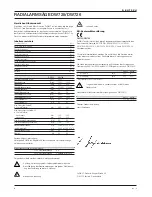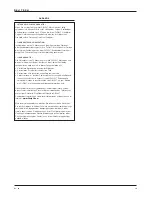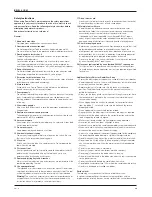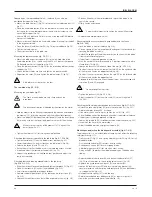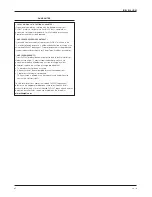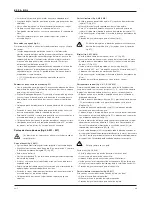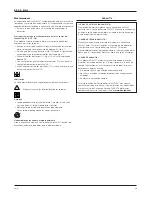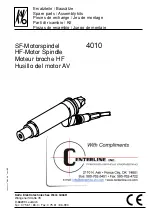
E N G L I S H
en - 4
22
Using an extension cable
If an extension cable is required, use an approved extension cable suitable
for the power input of this machine (see technical data). The minimum
conductor size is 1.5 mm
2
.
When using a cable reel, always unwind the cable completely.
Also refer to the table below.
Conductor size (mm
2
)
Cable rating (Amperes)
0.75
6
1.00
10
1.50
15
2.50
20
4.00
25
Cable length (m)
7.515 25
30
45
60
Voltage
Amperes
Cable rating (Amperes)
230
0 - 2.0
6
6
6
6
6
6
2.1 - 3.4
6
6
6
6
6
6
3.5 - 5.0
6
6
6
6
10
15
5.1 - 7.0
10
10
10
10
15
15
7.1 - 12.0
15
15
15
15
20
20
12.1 - 20.0
20
20
20
20
25
-
Three-phase machines should be wired directly into the mains by a
suitably qualified electrician.
Assembly and adjustment
• Prior to assembly and adjustment always unplug the tool.
• For optimum performance of your saw, it is of vital importance
to follow the procedures in the paragraphs below.
Assembling the legstand (fig. A1 & B)
The legstand components and fasteners are packed separately.
• Open the top of the carton (fig. B1).
• Remove all parts from the package, except for the arm .
• Lock the arm using the mitre clamp lever (10).
• Tilt the carton carefully until the column end of the carton is resting on
the floor (fig. B2).
• Pull out the arm and place a piece of wood (25) under the edge of the
table (fig. B3).
• Assemble the legs (5) using the nuts, bolts and flat washers from the
skinpack as shown. Do not yet tighten.
• Mount the traverse rails (26) (fig. B4).
• Firmly tighten all fasteners.
• Tilt the assembly to upright position.
The machine must be level and stable at all times.
Mounting the height adjustment crank (fig. C)
• Mount the height adjustment crank (12) on top of the column using the
cross head screw.
Mounting the roller head assembly (fig. A1, A2 & D1 - D3)
• Rotate the height adjustment crank (11) in the direction of the + to raise
the arm (12) as far as it will go (fig. A1).
• Remove the two Allen screws (27) and remove the end-cap (28) (fig. D1).
• Roughen the bearing tracks (29) using a steel wool pad and remove
any dust with a dry cloth (fig. D2).
• Make sure that the riplock (15) is released (fig. A2).
• Carefully insert the bearings (30) of the roller head assembly into the
bearing tracks (fig. D3).
• Move the roller head in the bearing tracks to check that it runs
smoothly.
• Check that the riplock will lock and release the roller head as required.
• Replace the end-cap immediately.
Mounting the cable support and cable clamp (fig. E1 - E3)
• Remove the cross head screw (31) (fig. E1).
• Mount the cable support (23) and refit the cross head screw.
• Remove the cable clamp (32) located on the arm and refit it holding the
cable in place (fig. E2).
• Fit the cable clamp (33) supplied to the rear on top of the table base
holding the cable in place (fig. E3).
Allow for the arm movement in horizontal and vertical direction.
Mounting the electronic control box (fig. E4)
Wired into the mains cable is the electronic control box (24) containing the
no-volt release switch, on three-phase models also including the braking
device and the motor overload protector with automatic reset.
• Remove the nuts from the screws protruding out of the rear of the box
(24).
• Hold the box against the rear of the table frame to the right of the
column base and insert the screws into the corresponding holes.
• Replace the nuts onto the end of the screws and tighten them.
The saw table (fig. F1 - F5)
Mounting the table supports (fig. F1)
The supports are mounted using M8 x 16 bolts and corresponding nuts
and with a D8 Belleville washer at the front, but not at the rear.
• Mount the two straight table supports (34) provided with a rectangular
recess (35) as shown. Note that they do not protrude from the rear of
the table base.
• Do not yet tighten the bolts.
Adjusting the table supports using the arbor (fig. F2 - F4)
• Release the bevel clamp lever (36) and pull out the bevel latch (37)
(fig. F2).
• Turn the motor to vertical position and lock it using the bevel latch and
the bevel clamp lever.
• Release the rip lock (15) and move the head to its fully forward position
(fig. F3).
• Loosen the mitre clamp lever (10) (fig. A1) to rotate the arm until the
arbor (38) is right above the outer front edge of one of the table
supports (fig. F4).
• Carefully lower the arm until the arbor just touches the table support
and tighten the corresponding nut of the table support manually.
• Repeat this procedure at the rear edge and for the other table support.
• Check again using the motor arbor.
• Firmly tighten all fasteners.
• Bring the arm back to the central position and lock it.
Adjusting the central table support (fig. F5)
• Place a level over the two straight table supports (34).
• Loosen the bolts (38) in the central table support (39).
• Adjust the central table support using an Allen key until it just touches
the level.
• Firmly tighten all fasteners.
Mounting the fixed table section (fig. F6 - F9)
The standard position of the table top sections is shown in
figure F6.
Summary of Contents for DW725
Page 1: ... DW725 DW726 ...
Page 3: ...A2 A1 4 1 13 12 2 3 11 6 5 7 9 10 8 14 15 16 17 18 21 20 19 23 22 ...
Page 4: ...11 D2 D3 C D1 B1 B2 B3 25 5 5 B4 26 28 27 29 30 ...
Page 5: ...E1 E2 E3 E4 23 31 32 33 24 F1 35 34 F2 37 90 36 F3 15 F4 38 ...
Page 7: ...48 4 G2 45 G3 47 46 G4 G5 45 G6 48 9 10 G7 G8 10 9 50 49 G9 ...
Page 11: ...M6 M5 60 62 88 M7 N1 N2 O Q1 63 103 Q2 104 103 ...
Page 12: ...Q4 Q3 104 103 104 105 2 Q5 Q6 108 S1 S2 119 109 116 112 110 T2 T1 ...
Page 14: ...U4 122 122 ...
Page 130: ......
Page 131: ......


